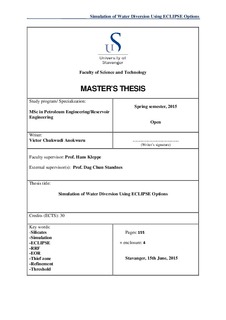| dc.contributor.author | Anokwuru, Victor Chukwudi | |
| dc.date.accessioned | 2015-09-23T06:49:03Z | |
| dc.date.available | 2015-09-23T06:49:03Z | |
| dc.date.issued | 2015-06-15 | |
| dc.identifier.uri | http://hdl.handle.net/11250/301300 | |
| dc.description | Master's thesis in Petroleum engineering. | nb_NO |
| dc.description.abstract | A recent large scale inter-well field pilot project on in-depth water diversion using silicates done at Snorre field in the Norwegian continental shelf (NCS) by Statoil ASA in 2013 revealed that even though the operation was successful, there are still several challenges in modeling the process. There are currently no known commercial software that has silicate-specific options that can simulate the physics and chemistry associated to this process. While research is ongoing to develop numerical codes that can simulate the water diversion process using silicates with significant accuracy, it is necessary to test the applicability of available options in commercial software that can give some insight into the process. This thesis uses the polymer option in ECLIPSE 100 to simulate water diversion using silicates. The idea is that since polymer and silicates share slightly similar characteristics with respect to gel formation, it is expected that the polymer option in ECLIPSE should be able to model to some extent the silicate water diversion process. Various 2D refined models were used to check the limits of refinement to obtaining realistic results and also for sensitivity on injection rate and thief zone location. 3D models were used to run sensitivity on important process design parameters such as activation temperature (gel location), injection time, slug size, permeability contrast and residual resistance factor (RRF). The grid size was found to influence the results and the 9x grid refinement gave acceptable results with minimal influence of numerical dispersion. Sensitivity on the injection rate using the 2D model indicated that the injection rate has no impact on the simulation results. However, this is not according to theory. It could be that the system here is not in a sensitive range with respect to the velocity variations. The 3D model sensitivities on design parameters gave expected and insightful results. It was observed that there is a threshold temperature of about 75oC at which the diversion process is most efficient. The sensitivity on the injection time revealed that the process will be more effective when applied earlier than later. Also, sensitivity results on slug size showed that the larger the silicate slug size, the higher incremental recoveries obtained, however, it could also mean lesser efficiency taking into consideration the amount of oil recovered compared to the amount of silicate injected and also the economics. In addition, the sensitivity on permeability contrast confirms literature. There is a threshold of permeability contrast above which the water diversion process becomes increasingly effective and profitable. The new keyword (PLYATEMP) in ECLIPSE was tested and ascertained to function as expected. Based on the results obtained and analysis made, it was concluded that the polymer option in ECLIPSE can be used to model in-depth water diversion with silicate. | nb_NO |
| dc.language.iso | eng | nb_NO |
| dc.publisher | University of Stavanger, Norway | nb_NO |
| dc.relation.ispartofseries | Masteroppgave/UIS-TN-IPT/2015; | |
| dc.subject | petroleumsteknologi | nb_NO |
| dc.subject | petroleum engineering | nb_NO |
| dc.subject | reservoarteknologi | nb_NO |
| dc.subject | silicates | nb_NO |
| dc.subject | simulation | nb_NO |
| dc.subject | eclipse | nb_NO |
| dc.subject | rrf | nb_NO |
| dc.subject | eor | nb_NO |
| dc.subject | thief zone | nb_NO |
| dc.subject | refinement | nb_NO |
| dc.subject | threshold | nb_NO |
| dc.title | Simulation of water diversion using ECLIPSE Options | nb_NO |
| dc.type | Master thesis | nb_NO |
| dc.subject.nsi | VDP::Technology: 500::Rock and petroleum disciplines: 510::Petroleum engineering: 512 | nb_NO |
